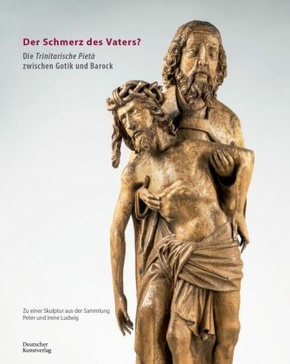Der Schmerz des Vaters? - Die trinitarische Pietà zwischen Gotik und Barock
| Verlag | Deutscher Kunstverlag |
| Auflage | 2021 |
| Seiten | 224 |
| Format | 22,8 x 2,5 x 29,9 cm |
| Gewicht | 1363 g |
| ISBN-10 | 3422987126 |
| ISBN-13 | 9783422987128 |
| Bestell-Nr | 42298712A |
Der Katalog zur gleichnamigen Ausstellung widmet sich erstmals dem im Spätmittelalter und in der Frühen Neuzeit verbreiteten Trinitätsbild mit dem Schmerzensmann, der trinitarischen Pietà. Es zeigt Gottvater, der seinen geopferten Sohn präsentiert; ebenso gehört die Taube des Heiligen Geistes zur Ikonografie. In diesem um 1400 entstandenen Bildmotiv wird das abstrakte Dogma der Trinität emotionalisiert und in ein lebendiges Andachtsbild gewandelt. Es findet sich in allen Medien - Malerei, Skulptur, Grafik, Angewandter Kunst - und ist nicht nur in Kirchenausstattungen, sondern auch im Bereich der privaten Frömmigkeit anzutreffen. Es zeigt sich, dass die Darstellungsform der Trinität auch im Zeitalter der Reformation bestehen bleibt, was die Aktualität dieses Themas von der Gotik bis zum Barock verdeutlicht.
Erste umfassende Darstellung der trinitarischen Pietà aus dem Mittelalter und der Frühen Neuzeit, die die Zeit der größten Verbreitung um 1500 einschließt Ausschließl iche Widmung des Bildes der Trinität mit dem Schmerzensmann Ausstellung: LUDWIGGALERIE Schloss Oberhausen, 2021/2022
For the first time the catalog accompanying the eponymous exhibition dedicates the trinity image with the Man of Sorrows that was widely known in the late Middle Ages and early modern period the trinitarian Pietà. It shows God the Father, who presents his sacrificed son; the iconography also includes the dove of the holy ghost. In this image created around 1400 the abstract dogma of the trinity is emotionalized and transformed into a vibrant devotional picture. It can be found in all media - painting, sculpture, graphic art, applied art - and is not only encountered in churches but also in the realm of private worship. What becomes apparent is that the manner in which the trinity is depicted remains the same in the age of reformation and this demonstrates the relevance of the topic from the Gothic to the baroque.
First comprehensive presentation of the trinitarian Pietà from the Middle Ages and the early modern era that includes the period of its greatest distribution ar ound 1500 Exclusive dedication of the image of the trinity with the Man of Sorrows Exhibition: LUDWIGGALERIE Schloss Oberhausen, 2021/2022

